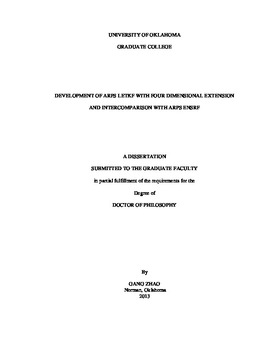| dc.description.abstract | The local ensemble transform Kalman filter (LETKF) has not been applied the storm-scale radar data assimilation (DA) problem until very recently. In this work, LETKF and its four-dimensional version, 4D-LETKF, are implemented within the Advanced Regional Prediction System (ARPS) ensemble DA framework. This LETKF system is first tested by assimilating simulated radar observations of a supercell storm through observing system simulation experiments (OSSEs).
The performance of the LETKF for radar DA is compared with the ensemble square root filter (EnSRF) in the ARPS DA system in the OSSEs. With the same optimal covariance localization radii, the performances of the EnSRF and LETKF are close to each other when their assimilation cycles reach the stable stage. In the earlier spin-up stage, when the state estimation and ensemble covariance are poor, the results of assimilating radial wind observations are also very close. When the radar reflectivity observations are assimilated, however, EnSRF outperforms LETKF during the spin-up stage. The differences are believed to be related to the nonlinearity of the reflectivity observation operator. The linearization for the nonlinear observation operator is implicitly made at different places in the serial EnSRF and simultaneous LETKF algorithm. This difference in effective linearization leads to systematic differences in the analyses of EnSRF and LETKF. This conclusion was further verified through several carefully designed experiments where the above differences are deliberately removed.
The performance of 4D- LETKF is then assessed and compared to the regular 3D-LETKF when analyzing radar batches spanning different time intervals. With the 4D-LETKF algorithm, high frequency observations distributed over time can be analyzed simultaneously without introducing observation timing error. Compared to 3D-LETKF with short, 1 minute intermittent assimilation cycles, 4D-LETKF can produce analyses of similar quality after a few DA cycles while reducing computational cost significantly by using fewer cycles. When using 3 minute or longer larger data batch, 4D-LETKF performs better than 3D-LETKF, mainly due to the observation timing error in 3D-LETKF. Considering the flow-dependence in error covariance, the effects of time localization and adaptive localization with a hierarchical filter (HF) are also tested within 4D-LETKF, respectively. The results show that both time localization and hybrid adaptive and non-adaptive localization can improve the performance of 4D-LETKF, especially when larger data batch length is large.
As an effort to enhance the balance in the analysis, divergence equation and pressure tendency equation are implemented as equation constraints in the ARPS-LETKF framework and tested through OSSEs. The analysis of pressure is improved, while the overall quality of analyses does not change much. | en_US |
